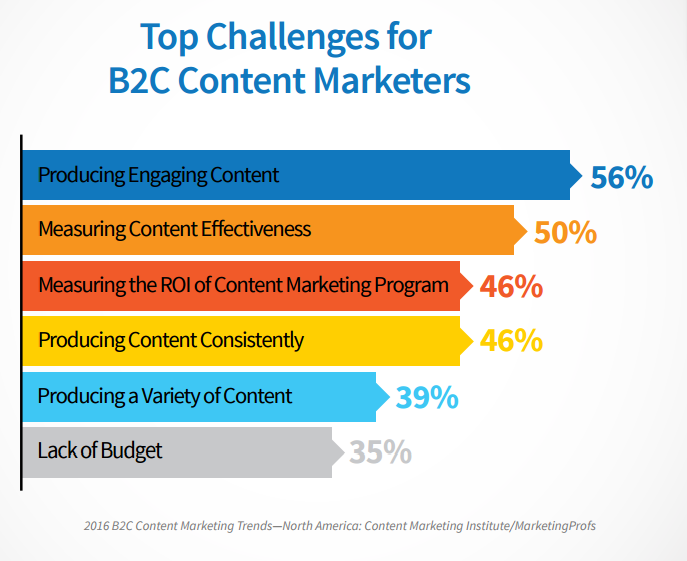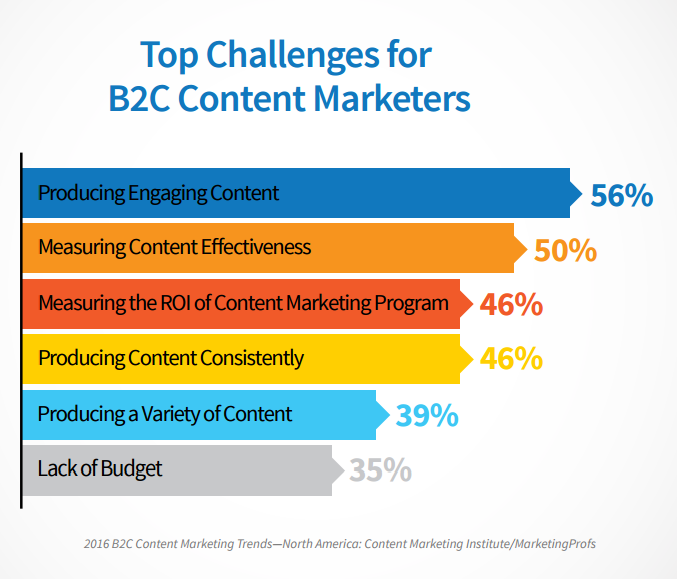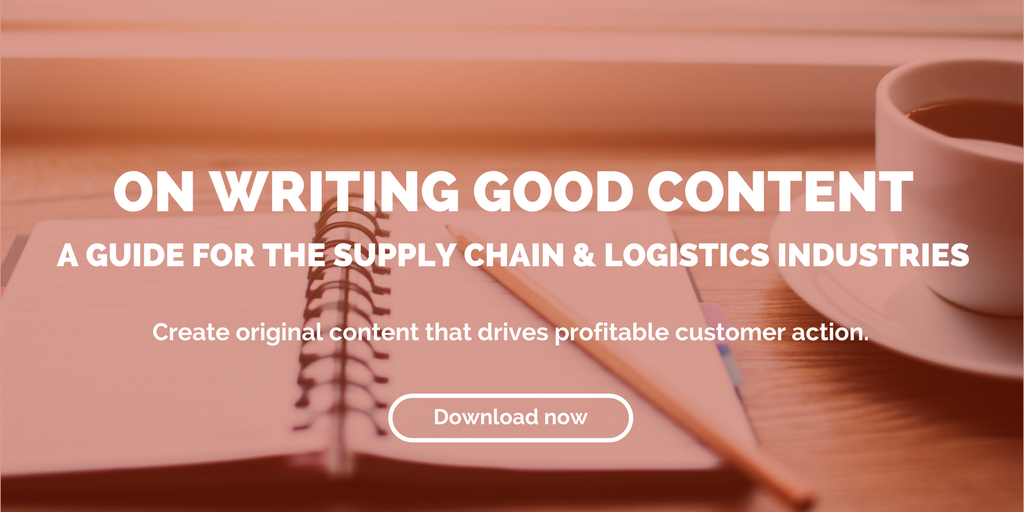
by Fronetics | May 25, 2016 | Blog, Content Marketing, Marketing, Strategy

Fronetics’ eBook lays out how to create a content marketing strategy that drives profitable customer action.
We hear it time and again: Clients want to participate in content marketing but are having trouble making it work for them. In fact, 70% of B2B marketers report their content marketing efforts are not successful.
The research is clear on why that is the case. Companies who have a documented content marketing strategy report significantly greater success than those without a strategy or those with an undocumented strategy. Yet only 32% of B2B marketers have a documented strategy in place.
Fronetics’ latest eBook directly addresses this concern. 12 Elements of an Effective Content Marketing Strategy is a resource for companies who want to launch a content marketing program that works — and for those who want their existing programs to achieve better results. The eBook offers a 12-step guide to creating a documented strategy that will be effective for your business. You will learn:
- How your business can benefit from content marketing
- The basic elements you need to create an effective content marketing strategy
- How to make your content stand out
- How to create a content marketing strategy that will drive profitable customer action
Download the ebook if you are interested in building a content marketing strategy that will generate leads, increase sales, and help grow your business.

Related posts:

by Fronetics | May 24, 2016 | Blog, Content Marketing, Marketing, Strategy

Outsourcing content marketing can cost a fraction of what dedicating in-house resources would — and you’ll get better results.
Nobody can do it all, despite what the latest motivational meme tells you. When running your business, it is vital that you focus on where you excel; sticking with your core competency is critical. Essentially, the more hats you wear in your company, the more watered down your efforts become.
Content marketing can be highly effective in generating leads and driving sales, but doing it right requires significant time and effort. If you are trying to manage content on top of overseeing key aspects of your business’ day-to-day operations, you are stretching yourself thin. What’s more, it’s negatively impacting your bottom line.
Why DIY content marketing can be costly
Many companies mistakenly think that managing their content marketing in house is simple, cost effective, and not time consuming. Actually, nothing could be further from the truth. Here is why:
Lost hours on your job
Taking time away from your primary focus prevents you from doing your job. If what you do best is new product development, for example, then dedicating hours each week to writing blog posts means that much less time for market research, design, and implementation. Those few hours away each week add up over time, and the cost to your company is significant.
Lost leads and sales opportunities
You may be a good writer and have personal social media accounts, but do you understand the ins and outs of creating and distributing content in a business setting? Professional content writers have expertise in search engine optimization (SEO), branding, user experience, and storytelling — all of which drive traffic and generate leads. Social media strategists similarly have expert knowledge of networking sites and how to best reach a target audience. If you don’t have that expertise, you are costing your company those opportunities — or, again, taking time away from your primary function trying to learn.
Lost readership and audience retention
If your content does not engage your audience, you shouldn’t have bothered in the first place. And engaging content doesn’t occur by happenstance. Research shows a strong correlation between content marketing success and strategy, documentation, and frequent check-ins. You need to know exactly who your audience is and what they want to read, and then you need a long-term plan for continually reaching them in new and interesting ways. Then you need to regularly assess your strategy and adjust as needed. As you can imagine, that all takes time and focus.
According to Forbes, outsourcing your content marketing is a cost-effective way to increase the success of your program. Essentially, you get expertise and experience — at a fraction of the cost of dedicating in-house resources — with no long-term commitment. By allowing experts to create strategies and leverage well-crafted, engaging content across multiple channels, you can improve lead generation and exponentially increase sales.
The Takeaway
By outsourcing your content marketing to the right firm, you can:
- Get professionally written, optimized content that engages your target customer and builds relationships.
- Benefit from the firm’s experience with content marketing for your industry and beyond.
- See results and ROI. The firm should put metrics on all of your marketing activities and deliver a regular report to you so you can monitor progress.
- Save time and money: You can focus on the core aspects of growing your business, while outsourcing your content marketing costs a fraction of dedicating in-house resources.
Simply put, it ultimately costs less to let experts create and execute your content. Given the reins, they can leverage their experience to produce greater results, capture more leads, analyze results, revise strategies, and, most importantly, free up your schedule to focus on your key responsibilities.
Related posts:

by Fronetics | May 23, 2016 | Blog, Content Marketing, Marketing, Strategy

Keep producing consistent, quality content during your slow season to win business when things pick back up.
For everything there is a season, and that expression holds true for most businesses. When is your slow season? That depends largely on your industry and customer demographic, but you are probably well aware which quarter your sales historically drop off and your customer engagement wanes.
In fact, the calendar is heading into a slow season for many companies, especially those in IT systems or the capital equipment marketplace. In these industries, the highest sales volumes typically occur in the first two business quarters. That is when potential customers are busy creating and implementing their new business initiatives and doing the bulk of their purchases for the year.
By third quarter, many businesses are past purchasing and have moved into problem-resolution mode. They are trying to meet the goals they set and stay within budget. Purchasing capital equipment is not on their agenda, at least not for now.
Should you head to the beach during that quarter? Should you ditch your current content marketing strategy because it suddenly is producing fewer leads? According to an insightful post from Daniel Pastuszak, marketing expert and head of customer acquisition and lifestyle marketing for LinkedIn, absolutely not. There is no indication that you should not market to your customers in your “off” season.
In fact, you need to maintain your “voice” as a thought leader, answer questions, and maintain a reliable, engaging presence through your content marketing. What will engage your audience during the slow cycles? Information, guidance, and memorable industry-related stories top the list.
Tips for effective content marketing during a slow season:
Provide content that demonstrates your expertise and positions you as a thought leader.
Don’t write a sales pitch! In your blog posts, offer helpful advice in an easy-to-digest format. For example, explain a recent case study or trend within your industry in a way your customers will understand it. This type of content keeps your customers engaged with your business, so when it comes time to purchase, they remember you as a trusted source of knowledge.
Share customer testimonials and their backstory.
Nothing is more memorable than telling a great success story. Now is the time to share reviews that demonstrate how your company expertly fulfilled customers’ needs, exceeded their expectations, or provided solutions to a tough challenge.
Cover events attended by your company’s management or leaders.
This can make for a great post on industry-related news, and can support branding the company as an industry leader. Again, there’s no need to include a sales pitch. You’re simply demonstrating how your company is among the movers and shakers in the industry.
Cultivate content that is fun, like customer contests.
Get customers involved with some friendly competition, and show them you are listening by sharing their responses. For example, one of Fronetics’ clients, a wholesale food distributor, recently challenged food service customers to create a meal using ingredients purchased from the wholesaler. They were then asked to post photos of their entries on social media with the contest hashtag. Fun and engaging, this contest captivated the customers’ attention and had them sharing content (and the client’s name).
Write for your (very specific) audience.
That means knowing who they are and what peaks their interest. If creating engaging content has proven to be challenging for your business, consider outsourcing your content creation, or your marketing program all together. Your slow season is the perfect time to boost the quality and consistency of your efforts to engage your audience and expand your outreach.
All businesses experience seasonal cycles, but that does not indicate your sales or content marketing strategies are in need of major revisions. Slow periods are the perfect time to take a deep breath, revitalize, and strategize. Use this time to research information you need to accelerate your efforts for the next hectic season of sales.
Related posts:

by Fronetics | May 17, 2016 | Blog, Content Marketing, Marketing, Strategy
Producing engaging content is the number one challenge for content marketers.
Is content marketing working well for your business? If not, you are not alone. Though it is one of the most effective ways to grow your business, content marketing has been challenging B2B and B2C organizations since its inception.
You may think it should be simple: Write, post, get more customers. But content marketing is much more complex, demanding more time, thought, and careful strategy than churning out a few blog posts. First and foremost, what you produce must engage readers. This is, however, the biggest content marketing challenge facing both B2B and B2C marketers.
2016 reports produced by Content Marketing Institute and MarketingProfs, and sponsored by Brightcove, found that the number one challenge for B2B and B2C marketers is producing engaging content.


Dull content and the domino effect
Unfortunately, if you lack engaging content, it works like a domino, knocking down all your other marketing efforts.
For one, it is much easier to gain the support of the C-suite, and be granted a reasonable budget, for your content marketing plan if you can show that your strategy is attracting more customers, helping with conversions, and driving sales. But if your content is not producing results, you won’t get the support and resources you need to produce the content, which, in turn, fuels results. It is a vicious cycle.
That being said, lack of engaging, quality content may be indicative of other challenges you may be facing, like the resources to produce content.
Creating engaging content
There are a few basics you must address if you are going to produce engaging content:
- Research your customer demographic. You must know who your audience is, what they want to know, how they want to learn it, and where to find them. Use web analytics to learn how your audience interacts with your website, what kinds of posts and emails they are reading, and where improvements can be made.
- Do your due diligence and learn how to reach those potential customers with topical information they want and will read. This means conducting a solid analysis of trends in your industry and producing content that offers expert information on these subjects or answers pressing questions potential customers may have about them. You, thus, will establish your organization as a trusted voice for your industry. This leads to dialogue with prospects and customers that want to learn more from you about industry news — or, even better, who are interested in your products or services.
- Research your distribution channels. This can affect not only what you post, but where and when you post it. Know your target’s social media habits, when they read emails, and what they are looking for. Research your competition and learn which channels they focus their attention on and why. Read the latest industry publications and influential blogs to uncover what topics work to engage their readers. Look for trends and answer to them.
- Look at SEO evaluations and site audits to help identify new middle- and bottom-of-the-funnel opportunities for content.
- Tell a story.
If creating engaging content has proven to be challenging for your business, consider outsourcing your content creation, or your marketing program all together. According to Social Media Today, lack of marketing staff can make it difficult for organizations to produce enough content to keep up with their competition.
Quality research and consistent creation of engaging, relevant content is time-consuming and requires keen writing skills. Promoting your posts on social media also takes time and requires consistent effort. Some of the most successful organizations put this task in the hands of an expert that can create and leverage content to provide the greatest impact to your brand, lead generation, and new customer conversion rate.
Related posts:


by Fronetics | May 5, 2016 | Blog, Content Marketing, Marketing, Strategy

Speak your boss’ language with metrics, statistics, and facts that articulate content marketing’s impact on customer acquisition and sales.
Garnering C-suite support for your content marketing program can be a challenge. Your team knows that your strategy is working by evaluating a series of metrics (e.g., shares, website traffic, email click-through rates), but executives do not always understand the value of such measures. It is almost like marketers speak another language.
So, how do you articulate the value of content marketing in a way that your executives will understand and support? Think of it this way: It is like that scene in the movie Jerry Maguire, only it is your boss demanding, “Show me the money!” The C-suite wants to know the cost to the company and the dollar amount of the return for any marketing initiative you undertake. Basically, you need to quantify success in terms of customer acquisitions and new sales.
Don’t focus on the secondary results, or “soft” metrics like per-post Facebook engagement. Talk the C-suite’s language, and demonstrate how your content marketing efforts led to new customers and what those customers are worth to the company’s growth and success.
Report these six metrics to win C-suite support
- Customer Acquisition Cost (CAC): This is the total average cost your company spends to acquire a new customer. Basically, what your company spends in marketing costs, divided by the number of new customers it produced.
- Marketing Percentage of the CAC: This is the marketing department costs divided the costs of the sales and marketing costs to get the marketing percentage of overall cost per new customer. The figure demonstrates if more is going into the sales team or the marketing team to produce the current result, and the lower the percentage the better.
- Ratio of Customer Lifetime Value to CAC: This figure estimates the total value that your company derives from each customer versus what you spend to acquire them.
- Time to Payback CAC: This estimate demonstrates how many months it takes for your company to earn back the CAC it spent acquiring your new customers.
- Marketing-Originated Customer Percentage: This is where you look at all of the new customers from a set time period and determine what percentage of them started with a lead generated by your marketing team.
- Marketing-Influenced Customer Percentage: This figure highlights all of the new customers that marketing interacted with at the time they were still just leads.
Additional selling points for content marketing
Content marketing can make a big impact on your company in terms of spreading brand awareness, growing your audience, and helping form business relationships. Though these benefits are difficult to quantify, try using the following statistics and facts to articulate the value your program could have in a way your executives will understand.
- As any business knows, it is essential to be where you customers are, and they are online. Your competitors know this, too. In fact, a recent study indicated that that 77% of companies surveyed, across industries, had plans to increase their digital marketing budgets in the coming year.
- The B2B buying process has evolved, and now content is an essential tool for generating and nurturing leads. Reportedly, 88% of B2B marketers use content marketing as part of their programs, with lead generation (85%) and sales (84%) being the most important goals.
- Blog content has long-term value, as what you post today may continue attracting traffic months (or years) from now. Your posts last indefinitely, outliving more traditional marketing methods, such as a print advertisement in a magazine.
- Consistently publishing quality content can earn your company a reputation as a thought leader in your industry. The public will come to trust your company as a respected source of knowledge, and you’ll begin forming relationships with readers who want to know more about your products and services. People buy from companies that they trust and feel connected to.
- Content marketing will get you more bang for your buck. Results are not instant, but, with time, you can actually reduce your marketing expenses while increasing your reach and growing your business.
- Content marketing is a valuable business intelligence tool. By distributing content through social media platforms, you not only engage potential customers, but you get their feedback and learn more about their needs and wants.
For more on marketing metrics that will articulate success to your boss, download Fronetics Strategic Advisors’ tip sheet.
Related posts:











